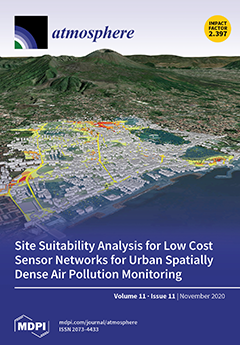Volatile organic compounds (VOCs), ozone (O
3), nitrogen oxides (NOx), carbon monoxide (CO), meteorological parameters, and total non-methane hydrocarbons (NMHC) were analyzed from simultaneous measurements at the MSU-IAP (Moscow State University—Institute of Atmospheric Physics) observational site in Moscow from 2011–2013. Seasonal and
[...] Read more.
Volatile organic compounds (VOCs), ozone (O
3), nitrogen oxides (NOx), carbon monoxide (CO), meteorological parameters, and total non-methane hydrocarbons (NMHC) were analyzed from simultaneous measurements at the MSU-IAP (Moscow State University—Institute of Atmospheric Physics) observational site in Moscow from 2011–2013. Seasonal and diurnal variability of the compounds was studied. The highest O
3 concentration in Moscow was observed in the summer daytime periods in anticyclonic meteorological conditions under poor ventilation of the atmospheric boundary layer and high temperatures (up to 105 ppbv or 210 μg/m
3). In contrast, NOx, CO, and benzene decreased from 8 a.m. to 5–6 p.m. local time (LT). The high positive correlation of daytime O
3 with secondary VOCs affirmed an important role of photochemical O
3 production in Moscow during the summers of 2011–2013. The summertime average concentrations of the biogenic VOCs isoprene and monoterpenes were observed to be 0.73 ppbv and 0.53 ppbv, respectively. The principal source of anthropogenic VOCs in Moscow was established to be local vehicle emissions. Yet, only about 5% of the observed isoprene was safely attributed to anthropogenic sources, suggesting significant contribution of biogenic sources into the total levels of ozone precursors. The non-linear O
3–NOx dependence shows a decrease in ground-level O
3 with an increase in NOx during the summers of 2011–2013, which is typical for the VOC-sensitive photochemical regime of O
3 formation. Nevertheless, during the elevated ozone episodes in July 2011, the photochemical regime of ozone production was either transitional or NOx-sensitive. Contribution of various anthropogenic and biogenic VOCs into the measured ozone values was evaluated. The ozone-forming potential (OFP) of total VOCs was 31–67 μg/m
3 on average and exceeded 100 μg/m
3 in the top 10% of high ozone events, reaching 136 μg/m
3. Acetaldehyde, 1.3-butadiene, and isoprene have the highest ozone production potential in Moscow compared to that of other measured VOCs.
Full article





